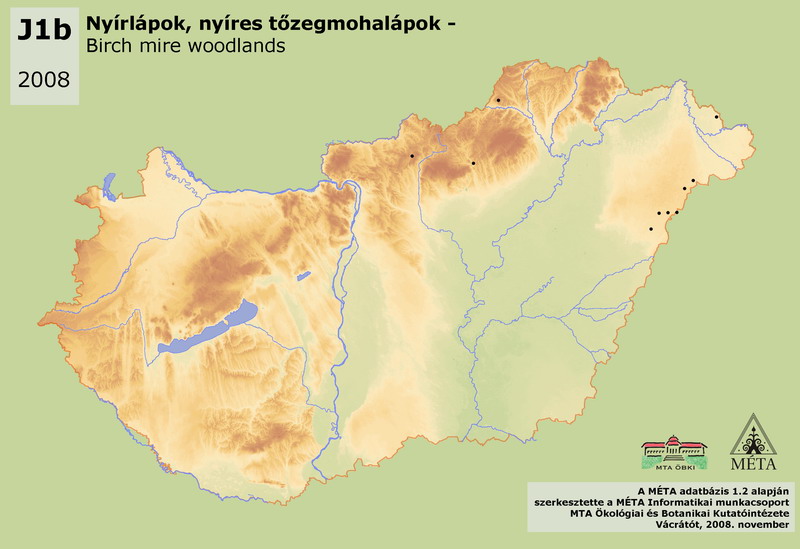MÉTA Program >>> Élőhelyek elterjedési térképei


J1b – Nyírlápok, nyíres tőzegmohalápok:
Lombkoronaszintjében nyírek által uralt, ligetes láperdők (záródás 40-80%). Lefolyástalan, pangó vizű medencékben, morotvákban megjelenő kis kiterjedésű állományok, az év nagy részében a talaj (ill. tőzeg) felszínéhez közeli, állandó felszín alatti vízborítás jellemzi őket. Talajuk tőzeg vagy tőzeges láptalaj, folyamatos tőzegképződéssel. Aljnövényzetükben jellemzőek a lápi és mocsári növények, uralkodók a sásfélék, a mohaszint borítása jelentős. Az egyik legritkább magyarországi élőhely, összesen 21 ha-t dokumentáltunk. Ritkaságát a lápok kiszárítása mellett elsősorban a termőhely eredendő ritkasága okozza. Domináns faja a Betula pubescens kissé gyakoribb.
J1b – Birch mire woodlands:
Mire woodlands dominated by scattered birch trees (closure 40-80%). The typically small stands occur in closed drainage basins and old oxbow lakes with stagnant water. Soil water is high (reaching the surface), the soil is peat, or peaty with ongoing peat formation. Mire and marsh species are usual, sedges are dominant in the herb layer, and the moss cover is significant. One of the rarest habitat of Hungary (21 ha). The stands can be found in the Északi-középhegység (Mátra: Sirok, Putnoki-dombság: Kelemér) and on Szatmár-Beregi-sík, as well as in the southern part of Nyírség. Besides the drying of former mires the rarity of the habitat can especially be explained by the natural rareness of suitable sites.
Molnár, Zs., M. Biró, J. Bölöni & F. Horváth (2008): Distribution of the (semi-)natural habitats in Hungary I.: Marshes and grasslands, Acta Botanica Hungarica 50 (Suppl): 59-105. >>> letöltés (5,4 MB, PDF)
MÉTA Program,
MÉTA Fotótár
MÉTA Élőhely-Ismereti Útmutató (ÉIÚ),
MÉTA Adatlap-Kitöltési Útmutató (AL-KÚ)
(C) MÉTA Informatika, 2005-2009,
MTA Ökológiai és Botanikai Kutatóintézete